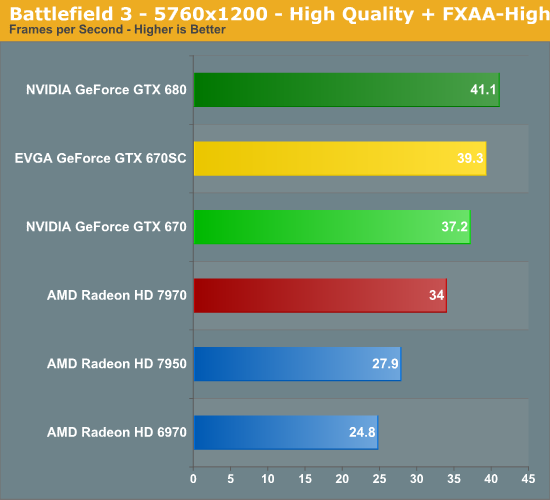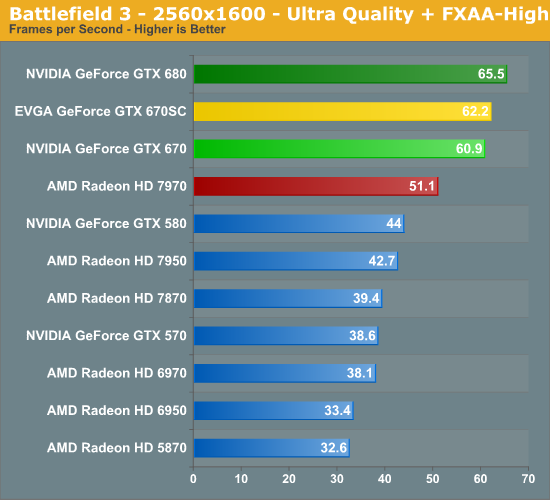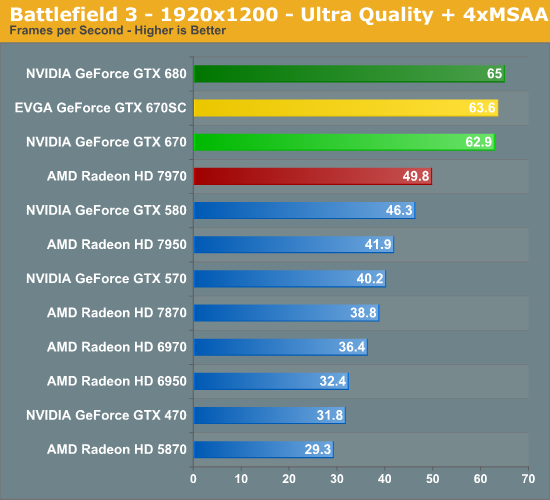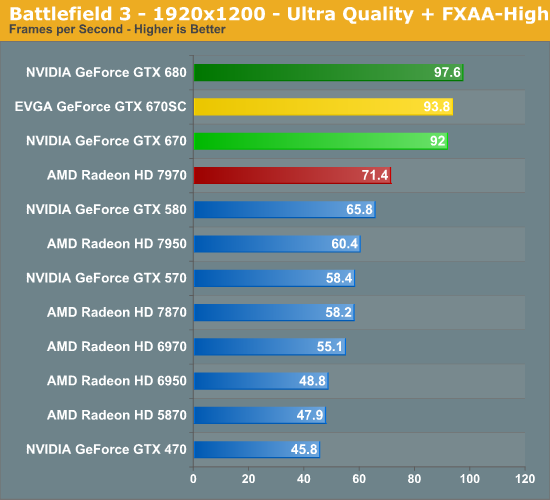NVIDIA GeForce GTX 670 Review Feat. EVGA: Bringing GK104 Down To $400
by Ryan Smith on May 10, 2012 9:00 AM ESTBattlefield 3
Its popularity aside, Battlefield 3 may be the most interesting game in our benchmark suite for a single reason: it’s the first AAA DX10+ game. It’s been 5 years since the launch of the first DX10 GPUs, and 3 whole process node shrinks later we’re finally to the point where games are using DX10’s functionality as a baseline rather than an addition. Not surprisingly BF3 is one of the best looking games in our suite, but as with past Battlefield games that beauty comes with a high performance cost.




Battlefield 3 has been NVIDIA’s crown jewel; a widely played multiplayer game with a clear lead for NVIDIA hardware. As a result the GTX 670 has another great showing here, easily outperforming AMD’s best. At 2560 with FXAA (and 1920 with MSAA) the GTX 670 has just enough performance to crack 60fps, which means it should be able to keep above 30fps even in larger firefights.
Interestingly enough however this is another game that the GTX 670 does very well at compared to the GTX 680. At 1920 with MSAA in particular the GTX 680 only leads by 3%, reinforcing the fact that as a consequence of giving the GTX 670 all of the GTX 680’s memory bandwidth that the GTX 680 doesn’t have very many tricks up its sleeve to lead with. This also means that the GTX 670 does particularly well here compared to the GTX 570, leading by 55% or more at every resolution and setting.










414 Comments
View All Comments
CeriseCogburn - Sunday, May 13, 2012 - link
This is your false claim about obviously. It's your and Charlie D's semi-accurate hit piece opinion and nothing else.dagamer34 - Thursday, May 10, 2012 - link
Products actually have to be consistently available for significant price drops like what you want to happen. Right now, if you need a high end card TODAY, waiting around for a GTX 680 isn't really an option, you'll have to go for the 7970 and AMD knows that.CeriseCogburn - Thursday, May 10, 2012 - link
Nope, 670 is all over the egg. Sorry you're late with that crap, and it's USA only BTW concerning 680 - the rest of the non obama world isn't suffering and can you really blame the asain(China/ commie cap government) manufacturers ?anubis44 - Friday, May 11, 2012 - link
"In the end they can't keep GK104 in stock anywhere and they still manage to beat AMD convincingly in both price and performance."You mean nvidia can't seem to make any. According to this article, nvidia has only been able to make a fraction of the GK104s that AMD has made Tahitis:
http://semiaccurate.com/2012/05/08/nvidias-five-ne...
That's what happens when you don't understand the manufacturing process you're moving to. You design a chip that's so ambitious, the failure rate is spectacular. AMD (and ATI before) on the other hand are much more familiar with the limits of successive process technology at TSMC, hence they are getting higher yields per wafer despite having a slightly larger die size, even without neutering their GPGPU compute circuitry like nvidia did.
eddman - Friday, May 11, 2012 - link
I wouldn't put too much weight in charlie's opinionated so called articles.CeriseCogburn - Friday, May 11, 2012 - link
If you read them on nVidia, and it is painful to see the twisted incoherent lies and completely contradictory links that disprove his stated reason for posting them or simply do not contain what he claimed they do, any bit of weight is too much weight at all.It's an amd fanboy firestarter flamer site, charlie's biggest purchase is red tipped matches and gasoline in a red can.
chizow - Sunday, May 13, 2012 - link
Can't agree with this for a lot of reasons. Maybe in the past with the huge GPU dies, but GK104 is *SMALLER* than Tahiti so there's really nothing ambitious about it.For capacities, Nvidia and TSMC have very close relationships and we know for a fact Nvidia is selling 2 GPUs for every 1 of AMDs, so Nvidia has an advantage there in terms of orders placed as well.
There's no reason to believe Nvidia is at any process disadvantage relative to AMD on 28nm, if anything everyone is supply constrained as other players try to move in (like Apple).
The fact there's plenty of GTX 670s still available after 3 days after launch with EXTREMELY favorable reviews tells me supply is excellent, and that Nvidia is only supply constrained on the high-end with perfect ASICs splitting good die between GTX 680 and 690.
chizow - Thursday, May 10, 2012 - link
Per usual Ryan, very relevant observations and interesting insight in regard to the changes Nvidia has made.I think I would take some of your first page insights a bit further:
1) GTX 680 is probably already heavily "overclocked" and binned to achieve a SKU Nvidia may not have planned originally, in order to beat the 7970 with a mid-range ASIC.
2) We will probably see an even more heavily harvested GK104 chip soon, given how little GTX 670 cuts from GTX 680 (just 1 SMX), but Nvidia can't cut too much without significantly impacting performance.
3) Pricing as you've laid out nicely, is probably $50-$100 too high across the board for all of these 28nm parts somewhere in the +20-25% premium range based on relative performance and historical pricing.
There's quite a few minor grammar errors throughout your article, nothing a quick proofread won't correct, but the content is excellent as usual.
Iketh - Thursday, May 10, 2012 - link
will you take the words "historical pricing" and remove them from your vocabulary? PLEASE?chizow - Thursday, May 10, 2012 - link
Its obvious the term is completely foreign to many here, including yourself, so until its well understood what it means and why its important and relevant to the discussion, I'll continue to use it."Those who do not learn from their mistakes are doomed to repeat them".
You're not even in a position to learn from your mistakes when you don't even understand the importance of "historical pricing".